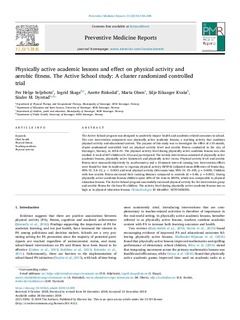| dc.contributor.author | Seljebotn, Per Helge | |
| dc.contributor.author | Skage, Ingrid | |
| dc.contributor.author | Riskedal, Anette | |
| dc.contributor.author | Olsen, Marta | |
| dc.contributor.author | Kvalø, Silje Eikanger | |
| dc.contributor.author | Dyrstad, Sindre Mikal | |
| dc.date.accessioned | 2019-01-22T13:48:48Z | |
| dc.date.available | 2019-01-22T13:48:48Z | |
| dc.date.created | 2019-01-11T12:41:42Z | |
| dc.date.issued | 2018-12 | |
| dc.identifier.citation | Seljebotn, P.H. (2018) Physically active academic lessons and effect on physical activity and aerobic fitness. The Active School study: A cluster randomized controlled trial. Preventive Medicine Reports. 2019, 13, pp. 183-188. | nb_NO |
| dc.identifier.issn | 2211-3355 | |
| dc.identifier.uri | http://hdl.handle.net/11250/2581809 | |
| dc.description.abstract | The Active School program was designed to positively impact health and academic-related outcomes in school. The core intervention component was physically active academic lessons, a teaching activity that combines physical activity and educational content. The purpose of this study was to investigate the effect of a 10-month, cluster-randomized controlled trial on physical activity level and aerobic fitness conducted in the city of Stavanger, Norway, in 2014–15. The physical activity level during physically active academic lessons was also studied. A total of 447 children (9–10 years) participated. The weekly intervention consisted of physically active academic lessons, physically active homework and physically active recess. Physical activity level and aerobic fitness were measured objectively by accelerometry and a 10-minute interval running test. Intervention effects were found for time in moderate to vigorous physical activity (MVPA) (adjusted mean difference of 8 min/day, 95% CI: 3.4–13, p < 0.001) and total physical activity (60 counts/min, 95% CI: 15–105, p = 0.009). Children with low aerobic fitness increased their running distance compared to controls (d = 0.46; p = 0.001). During physically active academic lessons children spent 26% of the time in MVPA, which was comparable to physical education lessons. The Active School program successfully increased physical activity for the intervention group and aerobic fitness for the least fit children. The activity level during physically active academic lessons was as high as in physical education lessons. | nb_NO |
| dc.language.iso | eng | nb_NO |
| dc.publisher | Elsevier | nb_NO |
| dc.rights | Navngivelse 4.0 Internasjonal | * |
| dc.rights.uri | http://creativecommons.org/licenses/by/4.0/deed.no | * |
| dc.subject | helse- og sosialfag | nb_NO |
| dc.subject | fysisk aktivitet | nb_NO |
| dc.subject | barnehelse | nb_NO |
| dc.subject | læremetoder | nb_NO |
| dc.subject | fysisk aktivitet på skolen | nb_NO |
| dc.subject | aktiv skole | nb_NO |
| dc.title | Physically active academic lessons and effect on physical activity and aerobic fitness. The Active School study: A cluster randomized controlled trial | nb_NO |
| dc.type | Journal article | nb_NO |
| dc.type | Peer reviewed | nb_NO |
| dc.description.version | publishedVersion | nb_NO |
| dc.rights.holder | © 2019 The Authors | nb_NO |
| dc.subject.nsi | VDP::Medisinske Fag: 700::Helsefag: 800 | nb_NO |
| dc.source.pagenumber | 183-188 | nb_NO |
| dc.source.volume | 13 | nb_NO |
| dc.source.journal | Preventive Medicine Reports | nb_NO |
| dc.identifier.doi | https://doi.org/10.1016/j.pmedr.2018.12.009 | |
| dc.identifier.cristin | 1654867 | |
| cristin.unitcode | 217,6,3,0 | |
| cristin.unitcode | 217,13,1,0 | |
| cristin.unitname | Institutt for grunnskolelærerutdanning, idrett og spesialpedagogikk | |
| cristin.unitname | Avdeling for folkehelse | |
| cristin.ispublished | true | |
| cristin.fulltext | original | |
| cristin.qualitycode | 1 | |

